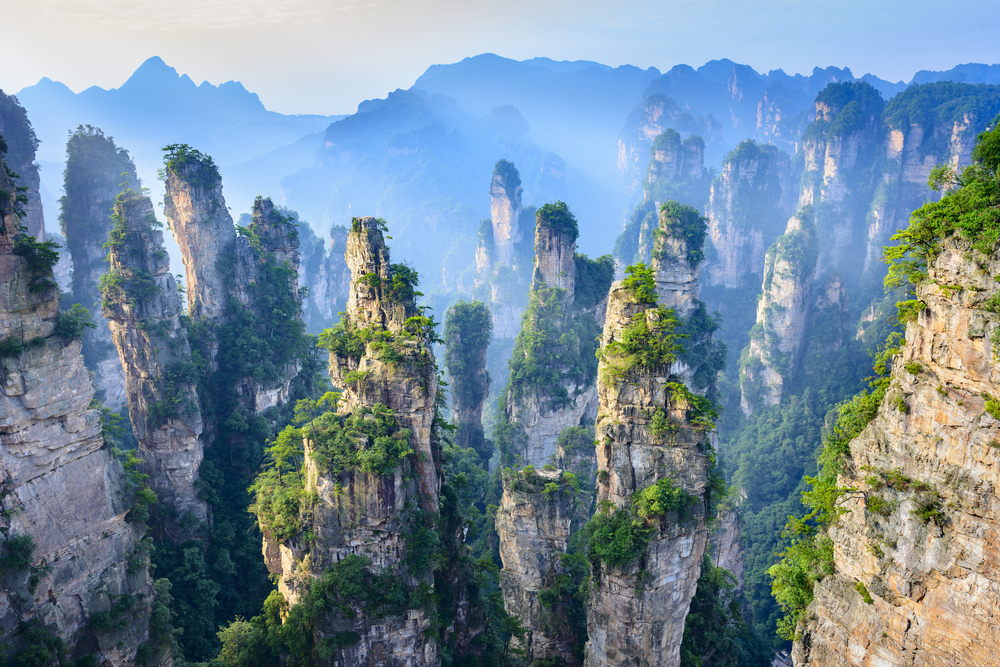
What are the Terrain Features of Zhangjiajie?
Zhangjiajie National Forest Park, located in Hunan Province, China, boasts a landscape of towering sandstone pillars, verdant valleys, and mist-shrouded peaks. The park is renowned for its unique rock formations, with some pillars reaching heights of over 200 meters (656 feet).
Geological Formations
The iconic sandstone pillars of Zhangjiajie are the result of a fascinating geological history spanning millions of years.
- Formation: These pillars were formed primarily by physical weathering and erosion. The process began with the deposition of quartz sandstone over millions of years, forming thick layers of rock. Over time, tectonic movements uplifted this region, creating cracks and fissures in the sandstone.
- Weathering and Erosion: Water, primarily in the form of rain and snowmelt, seeped into these cracks. As temperatures fluctuated, the water would freeze and expand, putting pressure on the rock and widening the cracks. This process, known as frost wedging, gradually broke the sandstone into smaller blocks.
- Wind and Water Action: Wind and rain further eroded the exposed surfaces of these blocks, rounding their edges and sculpting them into the pillar formations we see today. The flowing water also carved out the valleys and ravines that snake between the sandstone peaks.
Topography
Zhangjiajie's topography is a dramatic mix of towering heights and deep valleys.
-
Elevation: The park's elevation varies significantly, ranging from around 500 meters (1,640 feet) at its lowest points to over 1,300 meters (4,265 feet) at its highest peaks. This dramatic elevation change contributes to the formation of microclimates within the park, resulting in diverse flora and fauna.
-
Mountains and Peaks: The most prominent features of the park are its sandstone peaks, which number in the thousands. Some of the most famous peaks include:
- Avatar Hallelujah Mountain (Southern Sky Column): This towering pillar, reaching over 1,080 meters (3,540 feet), gained international recognition for inspiring the floating mountains in the movie "Avatar."
- Tianzi Mountain (Son of Heaven Mountain): Known for its cloud-kissed peaks, this mountain offers breathtaking panoramic views of the surrounding landscape.
- Huangshizhai (Yellow Stone Village): This plateau-like mountaintop is home to a dense concentration of sandstone pillars and offers stunning sunset views.
-
Valleys and Streams: The mountains are interspersed with deep, verdant valleys carved by rivers and streams. Golden Whip Stream, named for its winding path, meanders through a picturesque valley, offering a tranquil escape amidst the towering peaks.
Impact of Terrain on Ecosystem
The unique terrain of Zhangjiajie plays a crucial role in shaping its ecosystem:
- Microclimates: The significant variations in elevation create distinct microclimates within the park. Higher elevations experience cooler temperatures and higher rainfall, while lower elevations are warmer and drier. This diversity in climate supports a wide range of plant and animal life.
- Biodiversity: Zhangjiajie is a biodiversity hotspot, home to numerous endemic species found nowhere else on Earth. The varied terrain provides a range of habitats for these species, from the dense forests on the valley floors to the exposed cliffs favoured by certain bird species.
- Water Resources: The sandstone peaks act as natural water towers, absorbing rainfall and slowly releasing it into the streams and rivers that flow through the park. This helps to maintain water flow throughout the year, supporting the rich biodiversity of the region.
| Feature | Description |
|---|---|
| Sandstone Pillars | Formed by millions of years of weathering and erosion, these pillars are the park's most distinctive feature. |
| Elevation | Ranges from 500 meters to over 1,300 meters, creating diverse microclimates. |
| Famous Peaks | Include Avatar Hallelujah Mountain, Tianzi Mountain, and Huangshizhai. |
| Valleys and Streams | Carved by rivers and streams, these valleys provide a contrast to the towering peaks and support a rich ecosystem. |
FAQs
Q1: What is the best time of year to visit Zhangjiajie National Forest Park?
A: The best time to visit Zhangjiajie is during the spring (April-May) or autumn (September-October) when the weather is mild and the scenery is at its best.
Q2: How were the sandstone pillars in Zhangjiajie formed?
A: The sandstone pillars are the result of a long process of weathering and erosion. Wind, rain, and frost wedging gradually shaped the sandstone over millions of years.
Q3: What is the significance of Zhangjiajie's terrain for its ecosystem?
A: The varied terrain creates diverse habitats and microclimates, supporting a rich biodiversity of plants and animals. The sandstone formations also act as natural water towers, ensuring a consistent water supply for the ecosystem.